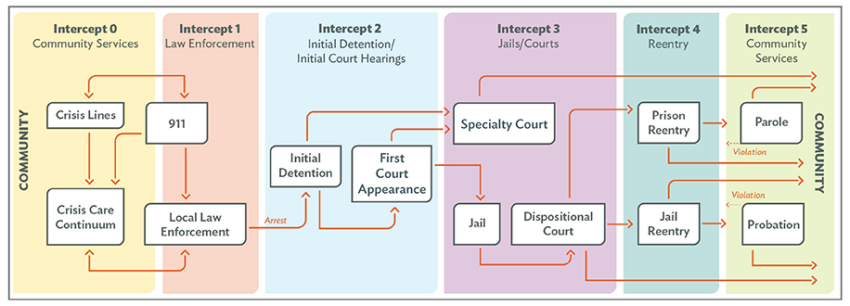Intercept 2 – Initial Detention/Initial Court Hearings
Proper training can improve outcomes for individuals with mental health and substance use challenges in initial detention centers and in the court system.

Intercept 2 – Initial Detention/Initial Court Hearings
If an individual is arrested at Intercept 1, they progress to Intercept 2. Intercept 2 occurs when an individual is detained and includes intake, booking and an initial hearing. The greater breadth and scope of services provided at this stage dictates that several more core competencies be required, including enhanced screening and assessment services, to best serve individuals with mental health and substance use disorders at this intercept. Staff should also become familiar with the Risk, Needs, Responsivity model as this modality has direct implications on the screening, assessment and referral process and when making recommendations to the court.
Intercept 2 CCBHC Integration Opportunities
- Screening, assessments and diagnoses for MH/SU conditions
- Data initiatives between the justice systems and MH/SU providers
- Pretrial diversion to reduce episodes of incarceration with local treatment
Screening, assessment and diagnosis are required core services for CCBHCs. Two-thirds (63%) of CCBHCs increased their efforts to engage with individuals who have justice system involvement or are at risk of being involved with the justice system, and 83% have targeted outreach to consumers who were previously incarcerated to bring them into treatment. Many CCBHCs (34%) have initiated data-sharing activities with law enforcement and/or local jails to support improved collaboration.
Intercept 2 Core Competencies
Collaboration and Teamwork
- Adopt a single system-wide county definition of key terms consistently used by local behavioral health systems, jails, courts and community corrections, including but not limited to:
- Substance use disorders
- Serious mental illness
- Recidivism
- Conduct a Sequential Intercept Model mapping workshop.
- Identify service capacity/interventions/gaps.
- Understand respective roles and responsibilities.
- Obtain leadership commitment (criminal justice council or task force).
- Develop collaborative criminal justice and behavioral task force if one does not already exist.
Workforce Development
- Provide cross-systems training on:
- Substance Use Disorder and MAT
- Implicit bias
- Data and evaluation
- Trauma-informed Care
- Mental Health First Aid (MHFA) for public safety
- Motivational Interviewing
- Screening, Brief Intervention and Referral to Treatment (SBIRT)
- Peer Navigators/Recovery Coaches
- Integrated mental health treatment for co-occurring substance use disorders
Screening and Assessment
- Assess the individual’s clinical and social needs and public safety risk.
- Implement validated screening and assessment tools and an efficient screening and assessment process.
- Inclusive of social determinants screenings and assessments
- Utilize the Risk, Needs, Responsivity (RNR) Model and ensure alignment with behavioral health treatment approach.
- Criminogenic risk
- Substance use/misuse
- Mental illness
- Share assessment information with partners to streamline workflow and coordinate care.
Care Planning and Care Coordination
- Develop process for linking to services (warm handoffs).
Cultural Humility
- Apply and address across remaining categories once competent in these principles:
- Implement/enhance anti-racist training and education.
- Adapt services to language, gender and pronoun preferences and cultural norms of population served.
- Promote diversity among staff teams, executive leadership, boards.
- Develop task force that is inclusive of individuals with lived experience to spearhead the implementation/assessment of anti-racist policies and procedures, training and education.
Racial and Ethnic Disparities
- Identify and address racial disparities within criminal justice system involvement and in health care access and quality for populations served.
- Develop task force for racial and ethnic disparities to help achieve the following goals:
- Set qualitative process and outcome goals for racial and ethnic disparity reduction.
- Set a numerical target for reducing justice system involvement and/or improving outcomes for Black, Indigenous and people of color (BIPOC).
- Set a numerical target for reducing the relative likelihood of justice system involvement for BIPOC compared to White adults.
Evaluation and Quality Improvement
- Develop a city/county-level training plan that includes quality assurance to ensure fidelity.
- Develop a city/county-level plan for information/data sharing.
- Data Collection Across the Sequential Intercept Model (SIM): Essential Measures
- Agree on how to measure recidivism and other health outcomes. For example:
- Recidivism outcomes:
- Reduction in police contact, arrest and reincarceration.
- Health outcomes:
- Reduction in wait time for accessing services.
- Track no-shows.
- Track medication refills.
- Rate of homelessness upon release/access to housing.
- Reduction in hospitalization/ER rates.
- Increase access to care coordination.
- Reduction in wait time for Medicaid reinstatement.
- Recidivism outcomes:
Funding and Sustainability
- Prioritize policy, practice and funding improvements.
- Understand Medicaid/SSA coverage.
- Routinely communicate with the people responsible for the county budget.
- Utilize data to justify funding.
- Explore federal funding opportunities.
National Council Resources
- 2021 CCBHC and Justice Systems Report
- 2022 CCBHC Impact Report
- Addressing Health Equity and Racial Justice Resource Directory
- Health Equity Resource Directory
- Trauma-informed, Recovery-oriented Systems of Care Toolkit
- The Intersection of Criminal Justice, Race and Addiction: The Case of Harold Easter
- Best Practices and Systems of Support for Justice-involved Veterans
- Trauma-Informed Care Screening and Assessment Toolkit
Want to Learn More?
- National Center for State Courts: Certified Community Behavioral Health Clinics (CCBHCs) and the State Courts
Relias Online Courses
Click here to access a wide variety of on-demand courses to enhance your care.
